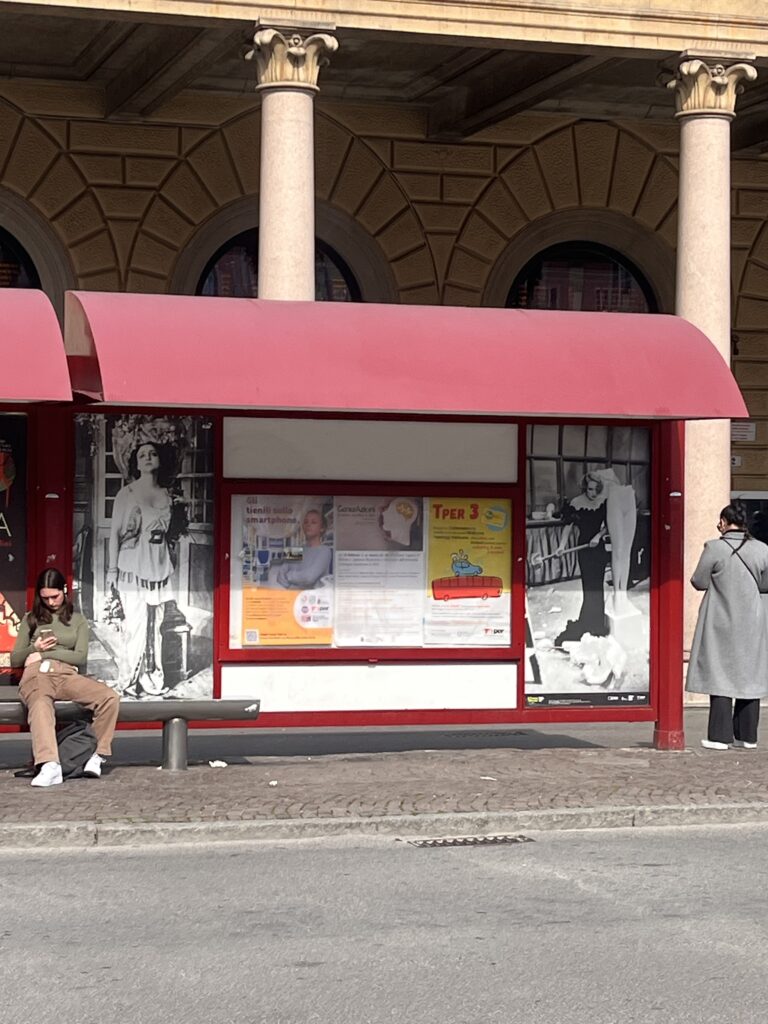La moda a Milano e la moda a Bologna
by Bella Lapp and Keon Eady
 Advertisements in Bologna’s city center
Advertisements in Bologna’s city center
Today, on March 8, the group traveled from Milan to Bologna via train. The economic landscape of each city was evidenced by advertisements in both cities. When we stepped off of the train platform in Milan, we were met with huge advertisements for luxury brands like Dolce & Gabbana, Prada, and Versace – which was completely contrasted by the street vendors selling mass-produced Italy-themed merchandise. It appeared that Milan is divided by an extreme wealth gap: those who can afford haute couture, the city’s source of economic & social power, and those who can’t. Bologna, on the other hand, had advertisements for cheap college degree programs, skincare, and technology (see pictures above and below). From the advertisements, architecture, and organizational layout of the city, Bologna visually communicates the way the city’s social and economic climate is shaped by students and activists. The radical political history of the city has shaped its identity, expressed through the lack of fashion advertisements. Milan’s city center is basically a giant shopping catalog, whereas Bologna’s Square is a hub for protests, artisans, and community events.
 A hand-painted clothing shop in Bologna’s city center
A hand-painted clothing shop in Bologna’s city center
As mentioned previously, Milan is home to many internationally renowned fashion designers and brands. Therefore, given the advertisements, the clothing sold reflects Milans reputation for sophistication, elegance, and innovation. It is easy to find the collections from well known Italian high fashion brands and they even include a wide selection from international luxury labels. Bologna on the other hand, a city with a grand student population and full of Italian culture, has a lot more boutiques and artisanal clothing available. This reiterates the creative and individualistic identities present in Bologna’s world of fashion. As a result, there is a noticeable difference in the street wear in Bologna. Bologna’s street wear lacks the prominent use of high fashion that Milans street wear has. It was very common in Milan to see a person wearing an outfit that included multiple designers in an effort to make a statement with the luxury brands they are wearing. This is not the case for Bologna, as the people here are much more creative with their outfits and they use that creativity to create their individual identity.
We arrived in Bologna on International Women’s Day, which we soon learned from professor Bruno Grazioli has historically been very important to the Bologna community. As we walked by the annual protest at around 5 pm, we saw a crowd of mostly black and pink (see picture below). From our perspective, both colors expressed a sense of solidarity and unity. Interestingly, however, there was no clearly no uniform, formal or informal, for the protest. Their messages were expressed through signs and chants, which were elevated by the lack of costuming. The only common symbol (besides the previously mentioned colors) we noticed were some women adorned with red paint streaks on their cheeks. This aspect of their dress visually communicated strength – specifically, collective political and social influence.
